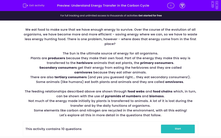We eat food to make sure that we have enough energy to survive. Over the course of the evolution of all organisms, we have become more and more efficient - saving energy where we can, so we have to waste less energy hunting food. There is one problem, however - where does that energy come from in the first place?
The Sun is the ultimate source of energy for all organisms.
Plants are producers because they make their own food. Part of the energy they make this way is transferred to the herbivore animals that eat plants, the primary consumers.
Secondary consumers get their energy from eating the herbivores and they are called carnivores because they eat other animals.
There are also tertiary consumers (and yes you guessed right... they eat secondary consumers!).
Some animals (like humans) eat both plants and animals and they are called omnivores.
The feeding relationships described above are shown through food webs and food chains which, in turn, can be shown with the use of pyramids of numbers and biomass.
Not much of the energy made initially by plants is transferred to animals. A lot of it is lost during the transfer and by the daily functions of organisms.
Some elements like carbon and nitrogen are recycled in the environment, with all this eating!
Let's explore all this in more detail in the questions that follow.








